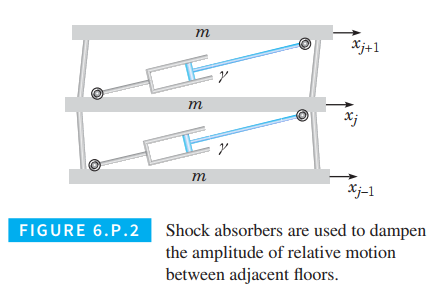
The Building with Damping Devices. In addition to flexural restoring forces, all buildings possess intrinsic internal friction, due to structural and nonstructural elements, that causes the amplitude of vibrations to decay as these elements absorb vibrational energy. One of several techniques employed in modem earthquake-resistant design uses added damping devices such as shock absorbers between adjacent floors to artificially increase the internal damping of a building and improve its resistance to earthquake-induced motion (see Figure

The effects of intrinsic and artificial damping are accounted for by including damping forces of the form
And
On the right-hand sides of Eqs .(1),(2), and(3), respectively.
(a) Show that including damping devices between each pair of adjacent floors changes the system
Where
(b) Assume an input to Eq. (i)in part (a) of the form
Thus the gain function for the frequency response of the
(c) Numerically approximate the solution of Eq. (i)in part (a) subject to the initial conditions
Want to see the full answer?
Check out a sample textbook solution
Chapter 6 Solutions
DIFFERENTIAL EQUATIONS-NEXTGEN WILEYPLUS
Additional Math Textbook Solutions
Graphical Approach To College Algebra
A First Course in Probability (10th Edition)
STATISTICS F/BUSINESS+ECONOMICS-TEXT
Elementary Statistics (13th Edition)
Thinking Mathematically (6th Edition)
 Discrete Mathematics and Its Applications ( 8th I...MathISBN:9781259676512Author:Kenneth H RosenPublisher:McGraw-Hill Education
Discrete Mathematics and Its Applications ( 8th I...MathISBN:9781259676512Author:Kenneth H RosenPublisher:McGraw-Hill Education Mathematics for Elementary Teachers with Activiti...MathISBN:9780134392790Author:Beckmann, SybillaPublisher:PEARSON
Mathematics for Elementary Teachers with Activiti...MathISBN:9780134392790Author:Beckmann, SybillaPublisher:PEARSON
 Thinking Mathematically (7th Edition)MathISBN:9780134683713Author:Robert F. BlitzerPublisher:PEARSON
Thinking Mathematically (7th Edition)MathISBN:9780134683713Author:Robert F. BlitzerPublisher:PEARSON Discrete Mathematics With ApplicationsMathISBN:9781337694193Author:EPP, Susanna S.Publisher:Cengage Learning,
Discrete Mathematics With ApplicationsMathISBN:9781337694193Author:EPP, Susanna S.Publisher:Cengage Learning, Pathways To Math Literacy (looseleaf)MathISBN:9781259985607Author:David Sobecki Professor, Brian A. MercerPublisher:McGraw-Hill Education
Pathways To Math Literacy (looseleaf)MathISBN:9781259985607Author:David Sobecki Professor, Brian A. MercerPublisher:McGraw-Hill Education





